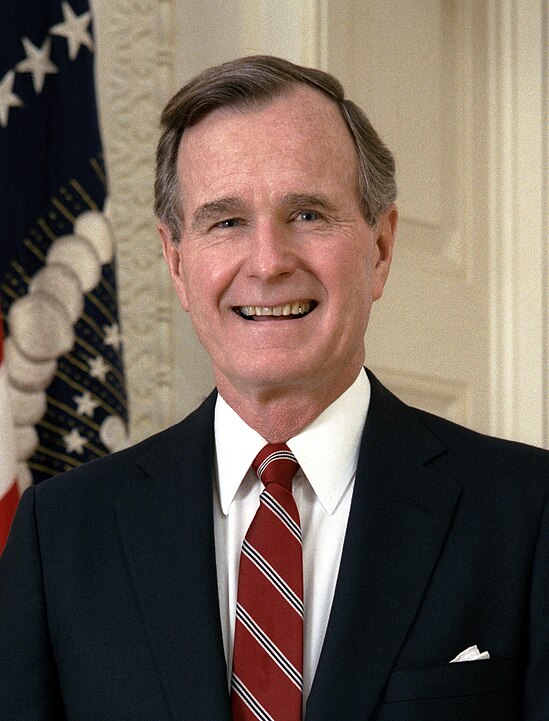George Herbert Walker Bush (1924-2018), who was the son of a U.S. senator from Connecticut, served from 1989 to 1993 as president of the United States. He previously served for eight years as vice president under Ronald Reagan with whom he had unsuccessfully vied for the 1980 Republican nomination.
Bush was born in Massachusetts and raised in Connecticut. After graduating from Phillips Academy, he joined the U.S. Navy, became an aviator, and was shot down by the Japanese in World War II but rescued.
After earning a degree from Yale, Bush went on to become a businessman before being elected to two terms representing Texas in the U.S. House of Representatives. He served in the Nixon Administration as ambassador to the United Nations and as chairman of the Republican National Committee, and served in the Ford Administration as a diplomat to China and as director of the Central Intelligence Agency.
Bush’s election and accomplishments
Although Bush was far less charismatic and articulate than his predecessor, Bush’s election was in some ways a vindication of the public’s satisfaction with the Reagan Administration. Bush promised a “kinder, gentler” nation and emphasized the importance of private organizations in serving as “a thousand points of light.”
One of his signal accomplishments was the adoption of the Americans with Disabilities Act of 1990, which prohibited discrimination based on such disabilities. The Clean Air Act Amendments of 1990 were also adopted during his administration. Bush ended up agreeing to tax hikes despite having won on a pledge of “no new taxes.” This turnabout, as well as a weakening economy, brought his defeat when he ran for reelection against Bill Clinton.
Bush’s presidency is probably best remembered for pushing Iraqi forces out of Kuwait after Saddam Hussein launched an invasion of that nation. Although Bush believed he had power to act on his own authority, he did secure prior congressional authorization for his actions. Bush was president when the Berlin Wall was demolished in 1989 and when the Soviet Union broke up two years later.
First Amendment Issues
Court upholds flag burning as symbolic speech
Bush had defeated Massachusetts Gov. Michael Dukakis in the presidential election of 1988 in part by charging that Dukakis was unpatriotic because he had failed to require the Pledge of Allegiance in public schools. (Han 2016, 563)
The most explosive First Amendment issue that emerged during the Bush Administration involved the Supreme Court decision in Texas v. Johnson (1989) declaring that burning the U.S. flag was a form of protected symbolic speech. Congress responded with the Flag Protection Act of 1989, which Bush, who doubted its constitutionality, allowed to become law without his signature. After the Supreme Court declared that law to be unconstitutional in U.S. v. Eichman (1990), Bush was unable to garner enough support for a constitutional amendment to overturn it (Han 2016, 565).
Although the Bush Administration had defended the action, the Supreme Court ruled in Lee v. Weisman (1992) that inviting members of the clergy to deliver invocations at public middle and high school graduations violated the establishment clause of the First Amendment as applied to the states through the 14th Amendment.
By contrast, in Board of Education of the Westside Community Schools v. Mergens (1990), the Supreme Court upheld the Equal Access Act.
Court’s ruling curbing religious freedom in jobs prompts new law
The Supreme Court’s decision in Employment Division v. Smith, ruling that a state could fire Native Americans for ingesting peyote as part of their religious exercises, later led to the adoption of the Religious Freedom Restoration Act of 1993 and to the Religious Land Use and Institutionalized Persons Act of 2000, both of which attempted to restore a higher level of scrutiny to laws affecting religious exercise than the Court had applied in Smith.
Bush opposed governmental funding of abortion, and in Rust v. Sullivan (1991), the Supreme Court ruled that the government was within its rights refusing to allow individuals who were receiving funding for reproductive health services to provide abortion counseling.
Bush appoints Souter, Thomas to Supreme Court
Bush brought a legacy of dignity and moderation to the White House. As president he had the opportunity to appoint two Supreme Court Justices. He appointed David Souter, who was generally regarded as a conservative moderate but who on the court would often side with liberals, to replace Justice William Brennan. He appointed Clarence Thomas to replace Thurgood Marshall. The latter appointment, which was highly contested after Thomas was accused of sexual harassment, was particularly consequential in that it replaced one of the most liberal members of the court with one of the most conservative.
Bush appointed Sonia Sotomayor (who later became a Supreme Court Justice) to the U.S. District Court for the District of Columbia. He also appointed Kenneth Starr, who would serve as the Special Prosecutor in investigating President Clinton, as his Solicitor General.
Bush’s son, George W. Bush, later served for two terms as president. His son, Jeb became governor of Florida but was an unsuccessful candidate for the 2016 Republican nomination for president.
John Vile is a professor of political science and dean of the Honors College at Middle Tennessee State University. This article was published on Jan. 14, 2024.

